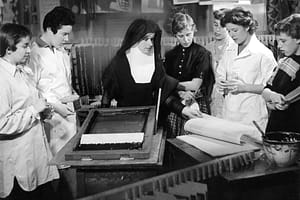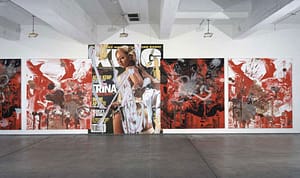Screen printing, also known as silkscreen printing, is a popular printing technique that artists use to produce fine art prints, posters, and other graphic art. It is a technique that involves the transfer of ink onto a surface using a stencil and a mesh screen. Screen printing is an old technique that has been used by famous artists throughout history. This article will explore some of the famous artists who used screen printing and the reasons why you should consider using this technique for your next artistic project.
Table of Contents
- Introduction
- Brief History of Screen Printing
- Famous Artists Who Used Screen Printing
- Andy Warhol
- Roy Lichtenstein
- Robert Rauschenberg
- Sister Mary Corita Kent
- Shepard Fairey
- Kelley Walker
- Advantages of Screen Printing
- Versatility
- Durability
- Cost-effective
- High-quality prints
- How to Create a Screen Print
- Materials Needed for Screen Printing
- Conclusion
- FAQs
Brief History of Screen Printing
Screen printing has been around for centuries. It originated in China and Japan during the Song Dynasty, where stencils were used to create intricate designs on silk fabrics. In the 20th century, screen printing became popular in the Western world, where it was used for commercial and artistic purposes.
Read here about history or screen printing.
Famous Artists Who Used Screen Printing
Andy Warhol

Andy Warhol, the father of pop art, is one of the most famous artists to have used screen printing. He used the technique to create his iconic silkscreen prints of celebrities like Marilyn Monroe, Elvis Presley, and Elizabeth Taylor. Warhol’s prints are highly sought after and have sold for millions of dollars.
Roy Lichtenstein

Roy Lichtenstein was another famous artist who used screen printing. He used the technique to create his iconic comic book-style paintings and prints, which are characterized by their bold lines and bright colors.
Robert Rauschenberg
Robert Rauschenberg was a pioneer of the pop art movement. He created his famous “Combines” with screen printing. These were mixed media artworks that combined painting, sculpture, and other art forms.
Sister Mary Corita Kent

Sister Mary Corita Kent was a nun and artist who used screen printing to create politically and socially conscious art. She used the technique to create posters and prints that promoted peace, civil rights, and social justice.
Shepard Fairey
Shepard Fairey is a contemporary artist who is known for his street art and political posters. He used screen printing to create his iconic “Hope” poster, which was used during Barack Obama’s presidential campaign.
Kelley Walker

Kelley Walker is contemporary artist who uses screen printing to create many of his works. He was born 1969 in Columbus, Georgia. His art features appropriation of iconic cultural images. He had many one-person exhibitions.
Advantages of Screen Printing
Screen printing has several advantages over other printing techniques. Some of the advantages include:
Versatility
Screen printing can be used on a variety of surfaces, including paper, fabric, metal, and plastic. This makes it a versatile printing technique that can be used for a wide range of artistic and commercial projects.
Durability
Screen printing produces high-quality prints that are durable and long-lasting. The ink used in screen printing is resistant to fading and can withstand exposure to the elements.
Cost-effective
Screen printing is a cost-effective printing technique, especially for large print runs. The cost per print decreases as the number of prints increases, making it a popular choice for commercial printing projects.
High-quality prints
Screen printing produces high-quality prints that are characterized by their vivid colors and sharp details. The ink is applied directly to the surface, creating a crisp, clear image.
How to Create a Screen Print
Creating a screen print involves several steps, including:
- Design: The first step in creating a screen print is to create a design. This can be done by hand or using digital software. The design is then transferred onto a stencil.
- Stencil: The stencil is placed on the screen, and ink is pushed through the stencil onto the surface. The areas of the stencil that are not meant to be printed are blocked out.
- Screen: The screen is made of a fine mesh material that allows ink to pass through. The mesh is stretched tightly over a frame, and the stencil is placed on top of the screen.
- Ink: The ink is poured onto the screen, and a squeegee is used to push the ink through the stencil onto the surface. The ink is then allowed to dry.
- Repeat: The process is repeated for each color in the design, with a new stencil created for each color.
Materials Needed for Screen Printing
To create a screen print, you will need the following materials:
- Screen: A screen with a mesh count appropriate for your project.
- Stencil: A stencil, which can be created by hand or using digital software.
- Ink: Screen printing ink in the colors of your choice.
- Squeegee: A squeegee to push the ink through the stencil and onto the surface.
- Surface: The surface that you will be printing on, such as paper, fabric, or metal.
Conclusion
Screen printing is a versatile and cost-effective printing technique that has been used by famous artists throughout history. Artists like Andy Warhol, Roy Lichtenstein, and Robert Rauschenberg used screen printing to create iconic works of art. Screen printing has several advantages over other printing techniques, including its durability, versatility, and high-quality prints. If you’re looking to create your own art prints, posters, or other graphic art, consider using screen printing for your next project.
FAQs
- Is screen printing expensive?
Screen printing can be expensive for small print runs but becomes cost-effective for larger print runs.
- What surfaces can be printed on using screen printing?
Screen printing can be used on a variety of surfaces, including paper, fabric, metal, and plastic.
- Can screen printing be done at home?
Yes, screen printing can be done at home with the right materials and equipment.
- How long does it take to create a screen print?
The time it takes to create a screen print depends on the complexity of the design and the number of colors used.
- Is screen printing eco-friendly?
Screen printing can be eco-friendly if eco-friendly ink and materials are used.